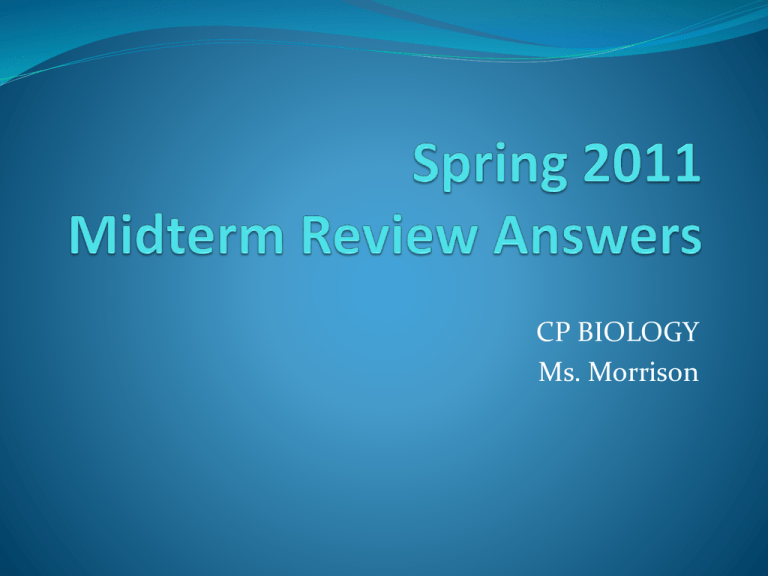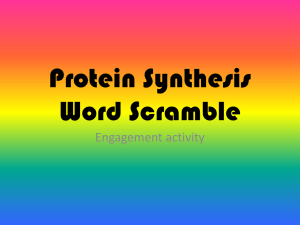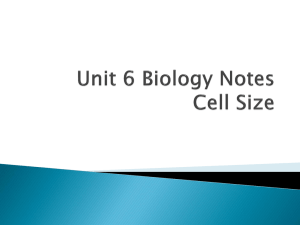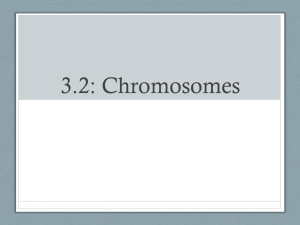
CP BIOLOGY
Ms. Morrison
1. What are gametes? How are they
created?
Gametes are haploid cells used in sexual reproduction.
Gametes are produced through the process of meiosis
which is a form of cell division designed to reduce the
number of chromosomes from diploid (2N) to haploid
(N).
2. What types of cells does meiosis create? How are
they different from those created by mitosis?
Meiosis creates haploid cells – this means that they
have only half the number of chromosomes found in
regular body cells.
Mitosis creates diploid cells that are identical to the
original cell. So, mitosis is used only to reproduce cells
asexually or to produce new cells in order for the
organism to replace old cells or to grow.
3. Explain crossing over. When does it
occur?
Crossing over is a process that occurs during prophase
I of meiosis.
During prophase I, the homologous chromosomes
with their copies form a tetrad structure where all four
chromatids are very close together. During this time,
parts of the chromosomes can exchange portions of
their chromatids.
3. Crossing over
4. Explain nondisjunction. When does it
occur? What does it create?
Nondisjunction occurs during Anaphase I of meiosis.
The homologous chromosomes separate during this
stage of meiosis, but when nondisjunction occurs, they
fail to separate properly.
It creates gametes that have the wrong number of
chromosomes – they do not have the chromosome or
they have too many of the chromosome.
Upon fertilization with another gamete, the embryo
can have only one copy (monosomy) or may have three
copies (trisomy).
5. Who discovered the structure of DNA?
Watson and Crick are credited at having discovered
the structure of DNA.
6 What is the structure of the DNA molecule called?
What makes up the sides and steps of it?
The DNA molecule has a shape called a double helix.
It looks like a twisted ladder.
The sides of the ladder are made up of sugars and
phosphate groups, while the steps are made up of
nitrogenous bases.
7. What are nucleotides? What are the 3
parts?
The molecules is made up of units called nucleotides,
which consist of three components:
A 5 carbon sugar – deoxyribose
A phosphate group
A nitrogenous base (thymine, cytosine, guanine, and
adenine)
NOTE: A (adenine) always pairs with T (thymine),
and G (guanine) always pairs with C (cytosine)
8. What is a codon?
A codon consists of three consecutive nucleotides that
code for a single amino acid in a protein. (It is the
sequence of the nitrogenous bases that make up the
codon.)
9. Describe what happens and where each
happens: Transcription
process of copying part of a DNA nucleotide sequence
into a complementary RNA sequence – making mRNA
from DNA in the nucleus (instructions for making a
protein)
RNA polymerase binds at the correct sequence of DNA
and separate the DNA strands
One of the DNA strands is used as a template to make
an mRNA strand
The mRNA strand is edited before leaving the nucleus
to go to a ribosome and be decoded
9. Describe what happens and where each
happens: Translation
protein synthesis, process of decoding an mRNA message
into a polypeptide chain, occurs in the cytoplasm at a
ribosome
mRNA attaches to a ribosome and the message starts being
read (AUG codon)
For each codon on the mRNA strand, the corresponding
tRNA with the anticodon pairs up with the mRNA
sequence
The tRNA molecules carry the amino acids which are then
bound together with a peptide bond to form the protein
When the stop codon is reached, the protein is complete
and it detaches from the ribosome
9. Describe what happens and where each
happens: Replication
process in which a DNA molecule makes a copy of
itself
The DNA molecule “unzips” its two strands so that
each strand becomes a template for making new DNA
molecules – done through base pairing
Each new DNA molecules has one old strand and one
new strand
DNA polymerase polymerizes the nucleotides into the
new DNA molecule and proofreads the sequence to
make sure that the bases are paired correctly
10. Replicate this DNA:
CGC TTA AGC CTA
GCG AAT TCG GAT
11. List 2 ways DNA and RNA are different.
Difference
DNA
RNA
Bases
thymine (T)
uracil (U)
Sugars
Deoxyribose
Ribose
Appearance
double strand
(double helix)
single strand
12. Define gene:
A gene is a sequence of DNA that codes for a protein
and thus determine a trait
13. What is the function of:
mRNA – contains the instructions for assembling
amino acids into proteins, instructions come from the
original DNA sequence (gene)
tRNA – transfers amino acids to ribosomes during
protein synthesis as specified by DNA (mRNA), each
tRNA has an anticodon which determines which
amino acid it transfers
14. Why are proteins important?
Proteins are important because they are used
structurally and chemically.
Structurally they make up the cytoskeleton and are
involved with movement of materials in the cell and in
and out of the cell.
Chemically they are important because they are
enzymes which are substances used to ensure that
reactions proceed normally. They bring substrates
together and lower the activation energy so that the
chemical reaction can occur.
15. What do you call a change in the DNA code that
causes a change in the protein that is produced?
Change in DNA code = mutation
Mutations can be point mutations in which a base is
replaced with another base in the sequence – this will
cause only one amino acid to change.
Mutations can be frameshift mutations in which a base
is added or deleted from the sequence – this will cause
all the amino acids past the change to be different.
16. Where is DNA located in an eukaryotic
cell?
In eukaryotic cells, the DNA is located within the
nucleus of the cell.
17. Must be able to convert DNA into mRNA and
read the codon to make an amino acid:
DNA:
TAC
GGG
CGA
mRNA:
AUG
CCC
GCU
Amino
Acid:
Methionine – Proline - Alanine
18. What is genetics?
The scientific study of heredity
19. Who is the father of Genetics?
Gregor Mendel
Austrian monk who in the mid 1800s taught high
school and took care of the monastery garden
Spent years studying the pea plants and controlling
their breeding to collect data on genetics
20. Define:
Genotype: genetic makeup of an organism – the actual
alleles the organism has for a specific gene (trait)
Phenotype: physical appearance of an organism –
what the organisms looks like
21. Define and give an example:
Homozygous dominant – having both dominant
alleles for a particular trait, ex. Tall pea plants – TT
Homozygous recessive – having both recessive alleles
for a particular trait, ex. Short pea plants – tt
Heterozygous – having one dominant allele and one
recessive allele for a particular trait, ex. Tall pea plants
- Tt
22. What is an allele?
An allele is a form of a gene.
Example – pea plant height
Can be either T (tall) or t (short)
23. Why are Punnett squares useful (what
do they tell us)?
Punnett square are diagrams used to show the genetic
combinations that might result from a genetic
offspring.
It gives us the ability to determine the chances of sex,
hair color, eye color, etc. for the offspring of two
parents when you know their genetic makeup.
24. Define and give an example of a trait
governed by:
Incomplete dominance: one allele is not completely
dominant and the other is not completely recessive, ex.
Four o’clock flowers – red and white flowers produce
pink (two phenotypes blend)
Codominance: both alleles contribute to the
phenotype, ex. Cattle – red and white cattle produce
roan cattle which have red and white hair together
Multiple alleles: gene has more than two alleles, ex.
Human blood types – have alleles for A, B, and O
Sex-linked traits: genes are found only on X or Y
chromosomes, ex. Color-blindness, hemophilia
25. On which chromosome are most sexlinked traits found?
Most sex-linked traits are found on the X chromosome
because it is much larger than the Y chromosome.
26. What is a carrier? (think sex-linked
traits)
A carrier is a person who has an allele for a particular
trait or disorder but does not show it in their
phenotype
Example: color blindness (sex-linked) – a woman can
have the allele for color blindness, but because her
other allele is normal she does not have color
blindness but may pass it on to her sons (have only one
X chromosome)
27. What are gametes?
Gametes are called sex cells. They are haploid cells
used in sexual reproduction. Each parent provides one
gamete with half the chromosomes needed to make
and adult organism.
28. What is a karyotype? Why is it useful?
It is a picture of a person’s chromosomes – they are
lined up by size and grouped in pairs. Must use cells
that are in the process of mitosis, since that is the only
time when the chromosomes are visible.
Used to determine sex and the presence of
abnormalities in the chromosomes – missing parts,
too many copies, etc.
29. What is a pedigree? Why is it useful?
A chart that shows the relationships within a family
Used to study how a trait is passed from one
generation to the next
Often used to track diseases or genetic disorders in a
family
30. Define each of Mendel’s Laws:
Unit Factors: Inheritance of characteristics are
determined by genes which are passed from parents to
offspring.
Dominance: When two or more forms of a gene exist,
some are dominant and some are recessive.
Segregation: Sexually reproducing adult organisms
have two copies of each gene – one from each parent.
These copies are segregated during gamete formation.
Independent Assortment: Alleles for different genes
usually segregate independently of one another during
meiosis.
31. Why is Darwin important?
Made a voyage around world and study the fossils,
living specimens, and environments of many
organisms.
Used data collected to develop the theory of evolution.
Published work in On the Origin of Species in 1859
32. Why are these biologists important to
evolution:
Lamarck: suggested that acquired behaviors/traits
could be passed on to offspring and a species could
change over time (wrong)
Hutton: geologist who suggested that layers on Earth
form very slowly and proposed that Earth much older
than thought
Lyell: geologists must explain past events using
processes currently happening
Miller & Urey: were able to form the organic
molecules necessary to life with the chemical
compounds found in Earth’s early atmosphere
32. cont’d
Lamarck – idea that species could change over time
based on traits passed to offspring
Hutton and Lyell – if Earth takes long time to change,
then organisms must change over time and this is a
slow process
Miller & Urey – early conditions on Earth could have
lead to the formation of living cells
33. Define:
Natural Selection: process by which individuals that
are better suited to their environment survive and
reproduce most successfully; also called survival of the
fittest
Artificial selection: selection by humans for breeding
of useful traits from the natural variation among
different organisms
34. What is the theory of natural selection?
What are the parts of this theory?
Theory of natural selection states that individuals that are
better suited to their environment survive and reproduce
most successfully – they show high fitness.
Organisms have a struggle for existence – this must
compete with other members of their species and with
other species for food, living space, and other necessities of
life.
Organisms with adaptations that make them more
successful have high fitness.
Over time natural selection results in changes in the
inherited characteristics of a species as successful
adaptations are passed to more and more offspring.
35. How did the Galapagos Islands contribute to
Darwin’s idea of natural selection?
The Galapagos Islands are a group of small islands off the
west coast of South America.
Even though the islands are close, they have very different
climates – some more desert-like and others more tropical.
He observed that the characteristics of many animals and
plants varied noticeably among the different islands.
His studies of his samples and observations lead him to
realize that similar species had adapted to the different
climate and vegetation available on the islands. Example,
tortoises on different islands have different length necks
and shells based on whether the vegetation is low to the
ground or higher off the ground.
36. How did geographic distribution of species
contribute to Darwin’s idea of natural selection?
Among the Galapagos Islands, Darwin had collected
samples of many small brown birds. Much later he came to
realize that despite all their physical differences they were
finches and most have common from finches found on
South America. So the birds had changed over time to
adapt to the conditions found on the islands on which they
lived.
Darwin also noticed that different animals that lived in
similar environments on different continents had similar
structures and behaviors, so they must have adapted
similarly to their environments through the process of
natural selection.
37. Define and give an example:
Homologous structures: structures that have different
mature forms but develop from the same embryonic
tissues, example: 4 limbed animals with backbones
have common ancestor
Vestigial structures: structures that have become very
reduced in size and not used in survival anymore,
example: hip bones in a whale, appendix in humans
38. What are fossils? Why are they useful?
Give 3 examples.
Fossils are the preserved remains or evidence of
ancient organisms.
They are useful because they provide evidence about
the history of life on Earth and how organisms have
changed over time.
Fossils can include animal bones, imprints left behind
from animals bodies, and insects and other organisms
trapped in amber.
39. What is a species?
A species a group of similar organisms that can breed
with each other and produce fertile offspring.
40. List 4 evidences for evolution.
Fossil record – shows how living things have evolved
over millions of years
Geographic distribution of living species – similar
species become different as adapt to different local
environments while different species living in similar
environments evolve common features
Homologous body structures – different organisms
with structures that have different forms in the mature
individuals but developed from the same embryonic
tissues
40. List 4 evidences for evolution. Cont’d
Similarities in embryonic development – many
animals show similar development patterns in their
embryos – help produce homologous structures
41. Define:
Macroevolution: large scale evolutionary changes that
take place over long periods of time
Microevolution: evolution that involves small scale
changes – changes within a species that occur over a
short period of time and result in the formation of a
new subspecies
Adaptation: an inherited characteristic that increases
an organism’s chance of survival
Mutation: a change in a DNA sequence that affects
genetic information









